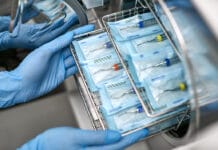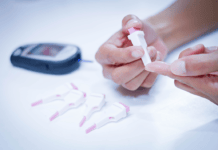The very first thing I learned clinically in dental hygiene school was hand hygiene. Proper handwashing was the first, and admittedly the most stressful, clinical competency on which we were evaluated. I remember practicing until my skin was chapped to ensure my technique was perfect.
Though we all need to know the correct technique and properly wash our hands, the Centers for Disease Control and Prevention (CDC) states that alcohol-based hand rubs can be used instead of soap and water for hand hygiene. The current guidance from the CDC states, “For routine dental examinations and nonsurgical procedures, use water and plain soap (hand washing) or antimicrobial soap (hand antisepsis) specific for health care settings or use an alcohol-based hand rub. Although alcohol-based hand rubs are effective for hand hygiene in health care settings, soap and water should be used when hands are visibly soiled (e.g., dirt, blood, body fluids).”1
However, there may be limitations as some viruses are much more difficult to manage with alcohol-based hand rubs. The problem lies in the fact that many non-enveloped viruses are resistant to alcohol-based hand rubs, and saliva is not visible.2
The Concern with Non-Enveloped Viruses
The human papillomavirus (HPV) is a sneaky virus. It can elude not only alcohol-based hand rubs but also most disinfectants. Studies have shown fingers and hands can be a reservoir for high levels of HPV DNA in patients with genital infections.3
HPV is also shed from the infected epithelial surface, including the oral cavity, in those with an oral infection. Therefore, it is plausible that the virus can also reside on the fingers of individuals with an oral infection, though no studies have been completed to confirm this.4
Furthermore, equipment that cannot be autoclaved can be a potential reservoir of viral particles. This could contribute to non-sexual transmission of the virus. This is an important thing to consider in dentistry to prevent cross-contamination and nosocomial infections. Barriers are useful in lowering the risk of cross-contamination with non-enveloped viruses.3,5,6
Enteric viruses, including norovirus, rotavirus, and astrovirus, are also non-enveloped viruses that are resistant to alcohol-based hand rubs. Since the discovery of enteric viruses, it has been established that the infection route was certainly fecal-oral. However, newer research has found that many enteric viruses may also replicate in the salivary glands, establishing the possibility of a new route of infection.2,7
Considering that these viruses also replicate in the salivary glands, it is imperative to conduct proper hand hygiene to prevent transmission to the clinician and/or other patients.7
Handwashing versus Alcohol-based Hand Rubs
The CDC states that “Alcohol-based hand sanitizers are the preferred method for cleaning your hands in most clinical situations.” They tend to be most effective for reducing pathogens on the hands of health care workers, but there are always exceptions.8
Though they are certainly convenient, it is important to recognize the limitations of alcohol-based hand rubs. Non-enveloped viruses, such as norovirus, HPV, and rotaviruses, are more resistant to pH and temperature changes. Furthermore, they are completely unaffected by some disinfectants, including alcohol. The alcohol is unable to penetrate the protein shell or capsid that protects the nucleic acid core. Disruption of the viral structure is required to inactivate or “kill” the virus.2,3
Alcohol’s mechanism of action against viruses is through the disruption of the lipid membrane or the envelope. Enveloped viruses require an intact lipid membrane or envelope to properly attach to and infect a host. Without it, the virus is inactivated and cannot infect a host. It has been well established that alcohol is effective for enveloped viruses yet ineffective against non-enveloped viruses.8
The popularity of alcohol-based hand rubs peaked during the COVID-19 pandemic, and they are certainly effective against coronaviruses because they are enveloped viruses. Therefore, it is imperative to understand that alcohol-based hand rubs are not useless in preventing viral infections, but they certainly have limitations.8
Handwashing with soap and water is superior in the cases of non-enveloped viruses. The mechanism of action isn’t the inactivation of the virus but rather the molecular makeup that allows for the removal of these viruses. Soap consists of molecules shaped like pins, each featuring a hydrophilic (water-attracting) head and a hydrophobic (water-repelling) tail that prefers to bond with oils and fats.10
In water, these molecules either move independently, interact with other molecules, or form small structures known as micelles, where the heads face outward and the tails are protected inside. During handwashing, soap micelles encase any pathogens on the skin. The hydrophobic tails seek to avoid water and, in doing so, insert themselves into the lipid layers of certain bacteria and viruses, disrupting them.10
However, some tougher microbes, such as non-enveloped viruses, are more resistant to the destructive mechanism yet can still be effectively removed. The removal of non-enveloped viruses occurs through thorough handwashing with soap and water, trapping the virus in the micelles, and washing them away without the need to inactivate the virus.10
The combination of the mechanisms of action exerted via hand washing with soap and water underscores why handwashing is often more effective than using hand sanitizer when considering non-enveloped viruses.10
Proper Handwashing Techniques in Health Care Settings
The CDC has provided guidance on proper hand hygiene in healthcare settings:8
- When cleaning your hands with soap and water, wet your hands first with water, apply the amount of product to your hands recommended by the manufacturer, and rub your hands together vigorously for at least 15 seconds, covering all surfaces of the hands and fingers.
- Rinse your hands with water and use disposable towels to dry. Use a towel to turn off the facet.
- Avoid using hot water to prevent drying of the skin.
- Other entities have recommended that cleaning your hands with soap and water should take 20 seconds.
- Either time is acceptable. The focus should be on cleaning your hands at the right times.
In Closing
Not all viruses are created equally. Some are far more resistant to alcohol-based hand rubs and, in some cases, even some hospital-grade disinfectants. This is not new information, but it seems to have gotten lost during the pandemic when alcohol-based hand rubs became the “go-to” for hand hygiene.
Though alcohol-based hand rubs are indeed effective at managing certain viruses and a slew of bacteria, handwashing remains superior in managing non-enveloped viruses. This is especially important in health care settings where patients are expected to be protected through proper infection control protocols. Therefore, if you have access to a sink and water, handwashing should be done instead of or in addition to using alcohol-based hand rubs.
Nonetheless, when soap and water are not available, alcohol-based hand rubs are a good second choice. When I was working clinically, I often did both to cover all the bases and ensure my hand hygiene would not contribute to cross-contamination or nosocomial infections. I encourage you to consider doing the same.
Before you leave, check out the Today’s RDH self-study CE courses. All courses are peer-reviewed and non-sponsored to focus solely on high-quality education. Click here now.
Listen to the Today’s RDH Dental Hygiene Podcast Below:
References
- Summary of Infection Prevention Practices in Dental Settings: Basic Expectations for Safe Care. (2016, October). Centers for Disease Control and Prevention. https://www.cdc.gov/dental-infection-control/media/pdfs/2024/07/safe-care2.pdf
- Wieselman, N. (2023, October 5). The Science of Alcohol-Based Sanitizers and Norovirus. International Sanitary Supply Association. https://www.issa.com/articles/the-science-of-alcohol-based-hand-sanitizers-and-norovirus/
- Solovey, M. (2014, February 12). Popular Disinfectants Do Not Kill HPV. The Pennsylvania State University. https://www.psu.edu/news/research/story/popular-disinfectants-do-not-kill-hpv/
- van Heerden, W.F., Bunn, B.K. Oropharyngeal Carcinoma: What the Dentist Should Know. Journal of the South African Dental Association. 2012; 67(10): 570-572. https://repository.up.ac.za/bitstream/handle/2263/21807/VanHeerden_Oropharyngeal_2012.pdf
- Ryndock, E., Robison, R., Meyers, C. Susceptibility of HPV16 and 18 to High Level Disinfectants Indicated for Semi-Critical Ultrasound Probes. Journal of Medical Virology. 2016; 88(6): 1076-1080. https://doi.org/10.1002/jmv.24421
- Sikora, A., Zahra, F. Nosocomial Infections. (2023, April 27). StatPearls. https://www.ncbi.nlm.nih.gov/books/NBK559312/
- Ghosh, S., Kumar, M., Santiana, M., et al. Enteric Viruses Replicate in Salivary Glands and Infect Through Saliva. Nature. 2022; 607(7918): 345-350. https://doi.org/10.1038/s41586-022-04895-8
- Clinical Safety: Hand Hygiene for Healthcare Workers. (2024, February 27). Centers for Disease Control and Prevention. https://www.cdc.gov/clean-hands/hcp/clinical-safety/
- Golin, A.P., Choi, D., Ghahary, A. Hand Sanitizers: A Review of Ingredients, Mechanisms of Action, Modes of Delivery, and Efficacy Against Coronaviruses. American Journal of Infection Control. 2020; 48(9): 1062-1067. https://doi.org/10.1016/j.ajic.2020.06.182
- Jabr, F. (2020, March 13). Why Soap Works. Yale School of Medicine. https://medicine.yale.edu/news-article/why-soap-works/












